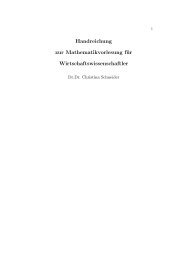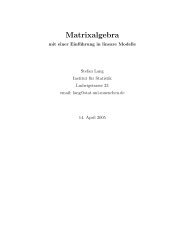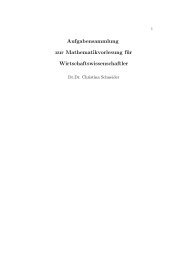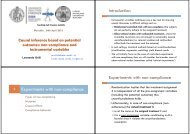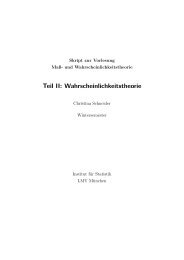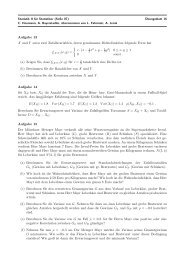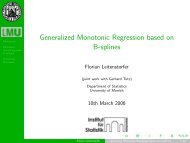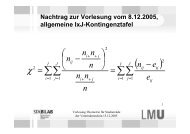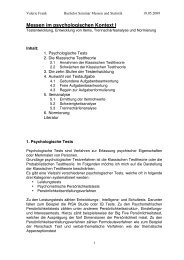Create successful ePaper yourself
Turn your PDF publications into a flip-book with our unique Google optimized e-Paper software.
4.3 Examples for using the cv.<strong>lqa</strong>() function 20<br />
penalty, control = control, intercept = intercept, standardize =<br />
standardize)<br />
Coefficients:<br />
[1] -8.560e-01 2.812e-01 1.404e+00 5.820e-02 -1.355e-07 -2.474e-01<br />
Degrees of Freedom: 99 Total (i.e. Null);<br />
Null Deviance: 123.8<br />
Residual Deviance: 62.05 AIC: 66.4<br />
97.8255 Residual<br />
The print() function for cv.obj shows the function call first. Afterwards information<br />
on the applied loss function, the existence of a validation data set, and the number of<br />
cross-validation folds are given. Thereafter the loss matrix is printed where each row<br />
corresponds <strong>to</strong> one tuning parameter candidate and the first columns correspond <strong>to</strong> the<br />
n.fold folds. The last column shows the values of CV(λ). As you can see, in our example<br />
λ = 0.5 delivers the smallest value and hence is regarded as optimal tuning parameter.<br />
Note that the difference <strong>to</strong> CV(0.05) is only small. Afterwards the so called best.obj,<br />
that is the GLM with the chosen penalty family and the optimal tuning parameter,<br />
is printed. This includes its (unstandardized) estimated coefficients and some model<br />
summary statistics.<br />
The cv.<strong>lqa</strong>() function can deal with cross-validation for up <strong>to</strong> three-dimensional tuning<br />
parameters. In this case printing of the loss matrix (which then in fact is a loss array)<br />
becomes quite striking for the user. Therefore a mean array is provided in those cases<br />
which just gives the CV scores and hence lowers the dimension of the loss array about<br />
one. To illustrate this we want <strong>to</strong> do cross-validation for our simulated data and now<br />
apply the fused lasso penalty. For λ 2 we consider just three candidates. The function<br />
call is<br />
R> cv.obj2 cv.obj2<br />
We just extract the mean array and the optimal tuning parameter in the following.<br />
mean array:<br />
lambda2 = 0.001 lambda2 = 0.01 lambda2 = 0.5<br />
lambda1 = 0.001 14.01300 13.55434 13.21141<br />
lambda1 = 0.05 13.14641 12.93533 13.24855<br />
lambda1 = 0.5 13.58486 13.53301 14.41157<br />
lambda1 = 1 15.48474 15.47385 16.22203<br />
lambda1 = 5 24.94260 24.94256 24.94281<br />
lambda.opt = 0.05 0.01



